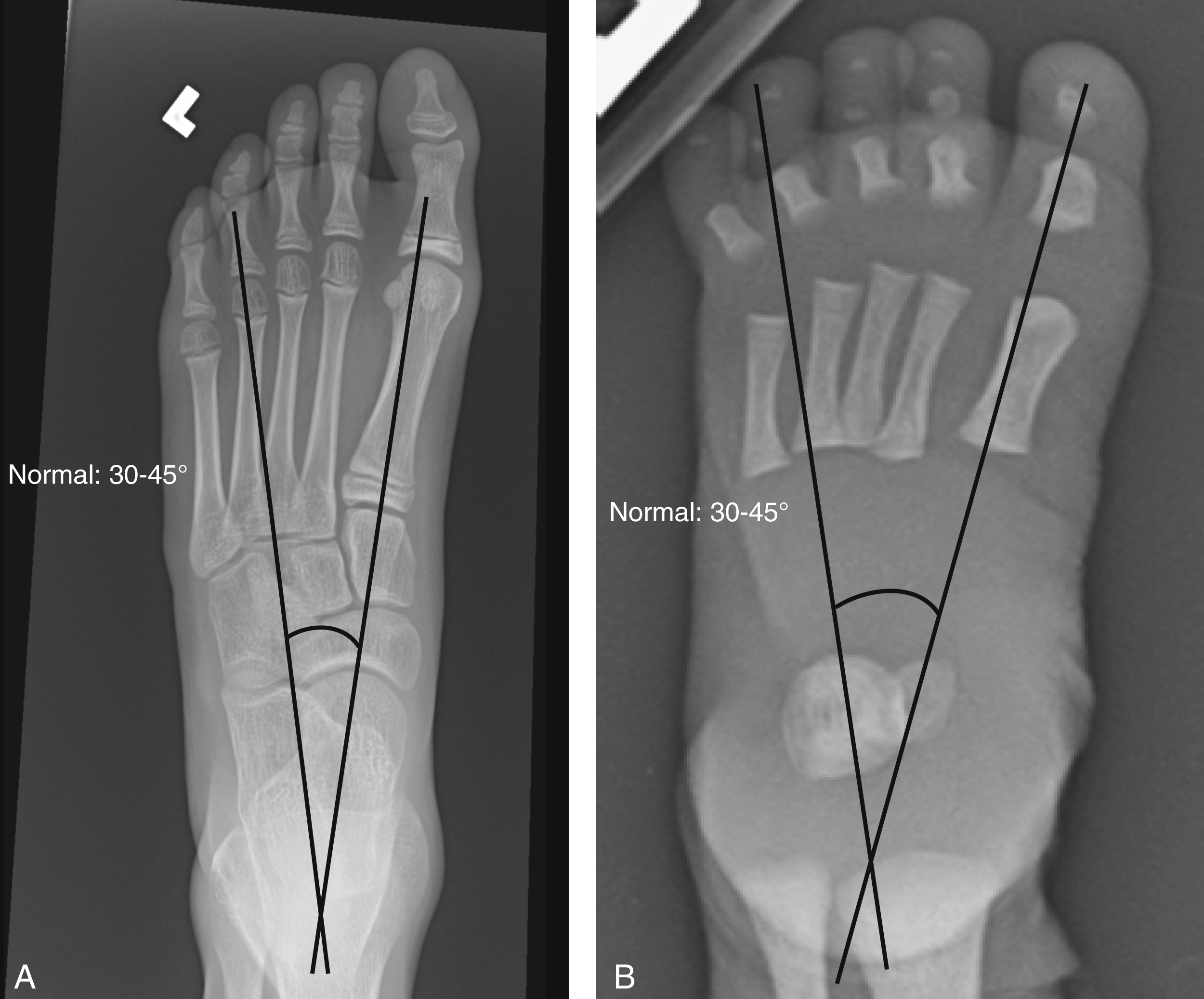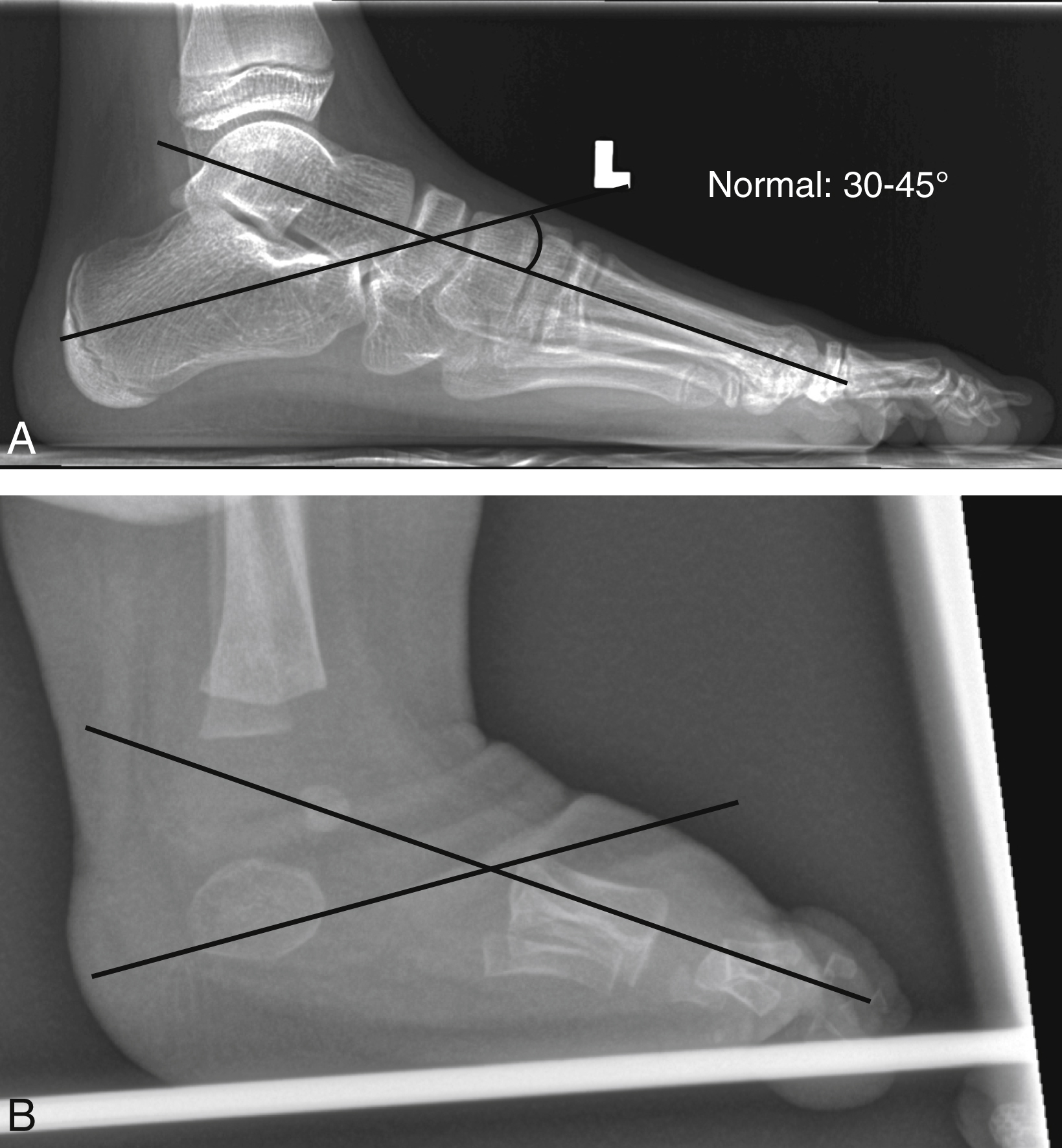Physical Address
304 North Cardinal St.
Dorchester Center, MA 02124
The pediatric foot can be complex, from both clinical and imaging perspectives. Acquired and congenital diseases can affect the foot, especially during early childhood development. Because radiographs are often first line in imaging, having an appreciation for the normal appearance of the developing foot and, similarly, what can go wrong, is paramount.
When imaging the foot, weight-bearing views (or simulated weight-bearing views in infants or nonambulatory patients) help evaluate the foot in its functional state. Both dorsoplantar (anteroposterior projection [AP]) and lateral views should be obtained, each with the tibia as perpendicular to the plain of the film as possible. Other views for more specific abnormalities may be required (e.g., the Harris view in suspected talocalcaneal coalition). However, initial imaging with these orthogonal views will help direct you toward more specialized views, as needed ( ).
The foot is divided into three sections: the hindfoot, the midfoot, and the forefoot. The hindfoot is composed of the talus and calcaneus. The midfoot is composed of the cuboid, navicular, and cuneiforms. The forefoot includes the metatarsals and phalanges.
At birth, the talus, calcaneus, cuboid, metatarsals, and phalanges are partially ossified. The navicular is the last bone to ossify (range, 9 months to 5.5 years).
A key point to keep in mind is that all of the bones of the foot have muscular attachments, except the talus. Because many foot deformities are related to underlying neurological or neuromuscular diseases, many of the bones of the foot are subject to changes in the setting of muscle or tendinous tension, and as a result can be anomalously positioned. The talus, however, is not so affected. As such, when analyzing foot abnormalities, one can typically assume that the talus is correctly positioned and can therefore evaluate the remaining bones of the foot with respect to their relationship with the talus (Ozonoff, 1992).
Heel alignment is best evaluated on the weight-bearing lateral view of the foot by assessing the tibiocalcaneal angle. The tibiocalcaneal angle is the angle between a vertical line through the axis of tibia and a line paralleling the axis of the calcaneus. The normal tibiocalcaneal angle measures between 55 and 90 degrees ( Fig. 12.1 ). In addition, a tangential line along the inferior surface or through the middle of the calcaneus will highlight a normal slight anterior dorsiflexion of 20 to 30 degrees.

When evaluating hindfoot alignment on the AP projection, the midcalcaneal line is drawn parallel to the lateral cortical surface of the calcaneus and normally intersects the base of the fourth metatarsal. The midtalar line is drawn parallel to the medial cortical surface of the talus and normally passes through or just medial to the base of the first metatarsal. A normal hindfoot will have a talocalcaneal angle of 30 to 45 degrees ( Fig. 12.2 ).

On the lateral view, hindfoot alignment is evaluated by drawing a tangential line along the inferior surface or through the middle of the calcaneus, and the midtalar line through the mid talus, which normally courses though or parallel to the shaft of the first metatarsal. A normal hindfoot will have a lateral talocalcaneal angle of 35 to 50 degrees ( Fig. 12.3 ). The normal navicular will be positioned directly opposite the talus. Talonavicular subluxation can often indicate hindfoot malalignment.

The plantar arch is assessed on the lateral weight-bearing film. In a normal weight-bearing foot the midline axis of the talus runs through the midline axis of the first metatarsal ( Fig. 12.4 ).

Finally, one should also keep in mind that on an AP view of the foot, the metatarsal bases should overlap just slightly. As described later, the amount of overlap can change with forefoot alignment abnormalities.
Specific terms are used to describe foot abnormalities, and as such, becoming familiar with them is necessary for accurate characterization of any abnormalities ( Tables 12.1 and 12.2 ).
| Terminology | Definition | Projection on Which Best Evaluated | Associations |
|---|---|---|---|
| Equinus | Plantar flexion of the calcaneus (anterior end depressed) | Lateral |
|
| Calcaneus | Dorsiflexion of the calcaneus (anterior end elevated) | Lateral |
|
| Valgus | Lateral deviation of the calcaneus/midcalcaneal line | Anteroposterior |
|
| Varus | Medial deviation of the calcaneus/midcalcaneal line | Anteroposterior |
|
| Pes cavus | Increased concavity/height of the plantar arch | Lateral |
|
| Pes planus | Flattening of plantar arch | Lateral |
|
| Rocker-bottom deformity | Convexity of plantar arch | Lateral |
|
| Terminology | Definition | Projection on Which Best Evaluated | Associations |
|---|---|---|---|
| Adduction/Varus | Angulation of the metatarsal heads, as a unit toward midline | AP |
|
| Abduction/Valgus | Angulation of the metatarsal heads, as a unit away from the midline | AP | |
| Inversion (varus and supination) | Medial rotation of the metatarsals (sole of the foot faces medial) | AP and lateral |
|
| Eversion (valgus and pronation) | Lateral rotation of the metatarsals (sole of the foot faces lateral) | AP and lateral |
|
Equinus positioning describes plantar flexion of the calcaneus such that its anterior aspect is depressed. With equinus positioning of the calcaneus, the tibiocalcaneal angle measures greater than 90 degrees ( Fig. 12.5 ). Note that equinus position can also refer to fixed plantar flexion of the entire foot.

Become a Clinical Tree membership for Full access and enjoy Unlimited articles
If you are a member. Log in here